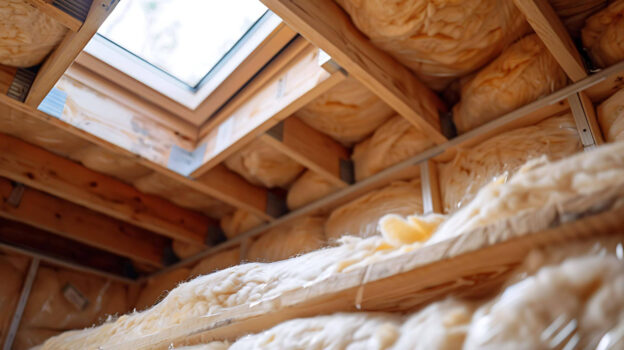As homeowners, we all desire a comfortable and energy-efficient living space that not only saves money but also promotes a healthier environment. One crucial aspect often overlooked is attic insulation and ventilation. However, proper insulation and ventilation in the attic play a significant role in maintaining an ideal indoor climate and safeguarding the overall structural integrity of your home. Sutter Roofing, being a leading roofing contractor, believes that it’s essential to spread awareness about the importance of attic insulation and ventilation, and how it can make a considerable difference in your home.
Attic insulation and ventilation go hand-in-hand in your home’s roofing system. Insulation helps to minimize heat transfer between the outdoors and your living area, while ventilation ensures that moisture and stale air are replaced by fresh air. Combined, these elements work together to maintain a comfortable indoor temperature, reduce energy costs, and prevent potential damage to your home’s structure.
Let’s start by discussing attic insulation. Insulation material is used to cover the attic floor, walls, and any other small gaps or openings to decrease heat transfer. This process prevents excessively hot air from entering your home during the summer months while retaining the warmth inside during the winter season. The benefits of proper attic insulation include reduced energy bills, improved temperature control, and lower HVAC equipment usage.
Attic Insulation: Choosing the Right Materials for Your Home
Selecting the appropriate insulation material for your home’s attic can make all the difference in the effectiveness of your insulation. There are several insulation materials available in the market, each with its own unique properties and advantages. Some popular options include:
1. Fiberglass: A widely used insulation material, fiberglass is lightweight and easy to install. It effectively traps air between its fibers, preventing heat conduction and providing excellent thermal resistance. Fiberglass comes in rolls or batts and can be easily cut into the desired shape.
2. Cellulose: Made from recycled paper, cellulose insulation is an eco-friendly and affordable choice. Loose-fill cellulose insulation can be blown or poured into place, filling gaps, cracks, and crevices to provide an effective barrier against heat transfer.
3. Spray Foam: Available in open-cell and closed-cell varieties, spray foam insulation expands upon application, filling gaps and providing an air barrier. It offers superior insulation properties and is particularly effective for insulating irregularly shaped cavities.
4. Mineral Wool: Also known as rock wool or slag wool, mineral wool is a naturally fire-resistant insulation material. This characteristic makes it an excellent choice for regions prone to wildfires or for homes that require additional fire protection.
Proper Attic Ventilation: What to Consider
To make the most out of your attic insulation, ensuring adequate ventilation is crucial. Ventilation is a two-step process involving the exhaust of hot, moist air and the intake of cooler, fresh air. Here’s what to consider for effective attic ventilation:
1. Types of Vents: Roof vents, ridge vents, soffit vents, and gable vents are common attic ventilation options. Each type serves a specific purpose and can be installed in various combinations to suit the needs of your home.
2. Vent Sizing: Proper vent sizing is essential to effectively remove stale air and moisture from the attic. It’s recommended to maintain a 1:300 ratio of ventilation area to the attic floor area. For example, an attic with 900 square feet of floor space would require three square feet of ventilation.
3. Vent Placement: Correct placement of vents ensures that fresh air fills the entire attic space. Soffit and gable vents are typically used for intake, while ridge and roof vents serve as exhaust outlets. This placement allows for the proper movement and circulation of air.
4. Attic Ventilation Maintenance: Keep your vents clean and functional by periodically checking for debris, animal nests, and other obstructions. Also, regularly inspect the vent screens to ensure they’re in good condition.
Signs of Inadequate Attic Insulation and Ventilation
Ignoring attic insulation and ventilation issues can lead to costly repairs and energy inefficiencies in the long run. Keep an eye out for the following warning signs that could indicate problems with insulation or ventilation:
1. Temperature Fluctuations: Noticeable variations in indoor temperatures, especially on the upper floors, can be a sign of insufficient insulation and ventilation.
2. High Energy Bills: If your home’s heating or cooling costs seem unusually high, inadequate attic insulation and ventilation could be the culprits.
3. Condensation and Mold: Condensation on ceilings or walls, damp insulation, and mold growth are all signs of excess moisture in the attic, indicating poor ventilation.
4. Ice Dams: In colder climates, accumulated ice on the eaves or icicles hanging from gutters are visual indicators of ice dam formation. This problem is often caused by inadequate attic insulation and ventilation.
Expert Tips for Proper Installation and Maintenance
To maximize the benefits of attic insulation and ventilation, follow these expert tips from Sutter Roofing:
1. Seal Air Leaks: Before installing insulation, identify and seal air leaks around wiring, plumbing, vents, and electrical outlets. This prevents drafts and maintains the effectiveness of insulation.
2. Install Insulation Correctly: Ensure proper installation by following manufacturer guidelines and local building codes. Inadequate or improper installation can reduce the effectiveness of your insulation.
3. Check R-Value: Choose insulation materials with the appropriate R-value for your region and climate. The R-value measures the material’s resistance to heat transfer. The higher the R-value, the better the insulation.
4. Keep Vents Clear: Regularly inspect your attic vents to prevent blockages from debris, pests, or damaged screening.
Conclusion
Investing time and effort in your home’s attic insulation and ventilation system reaps long-term rewards in energy efficiency, cost savings, and improved comfort. By choosing the right materials, maintaining proper ventilation, and addressing issues promptly, you can ensure optimum performance and extend the life of your roofing system.
For a professional assessment of your attic and expert guidance on improving its insulation and ventilation, get in touch with Sutter Roofing today. Let us help you create a healthier and more comfortable environment for your home.








